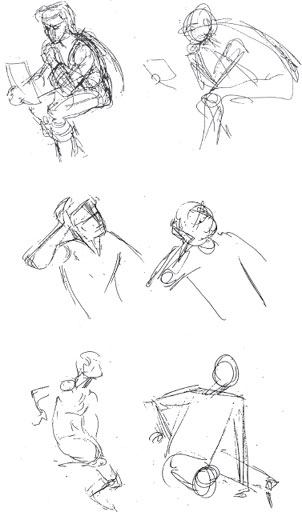92 Do You Promise to Draw the Action, The Whole Action, and Nothing But the Action?
When you perform a movement of some kind, your body, without you having to think too much about it, does it for you. All you have to do is tell it to pick up a cup, or open the newspaper to page three, or pull the starter cord to start your mower motor. Each of these actions takes a different set of muscles, in various combinations of bends, stretches, twists, and balances. It is truly amazing how dexterous you can be with little or no practice. You might even appear graceful, forceful, serious, or comical, depending on the nature of the move, also how you desire to appear.
When you do these moves, you don’t get involved with what muscles are used or what bones those muscles are attached to. And you certainly don’t have to be concerned with how many heads tall you are. If you’re short you don’t have so far to reach for something on the floor, but farther to reach for something over your head. But whatever, your body takes care of all the necessary adjustments. What goes through your mind is simply “Reach for this, bend for that, lean into this, twist for that,” etc.
How does all this apply to drawing? In drawing, you suddenly have to become conscious of the action that is required; you have to draw a bend, or a stretch, or a twist, not just do it as in real life, without having to analyze the component parts of the move. Up until the time you decided to draw, you lived without having to give all this subtle body manipulation a second thought. So now you have to investigate, examine, study, dissect, and think through what you do when you move.
One of the great violinists who played in concerts at a very early age, realized, in his teens, that he didn’t really know how he played the violin. If suddenly this ability left him, he wouldn’t be able to perform. So in his late teens he took violin lessons.
You are in a somewhat similar position, because all your life you have performed an infinite combination of bodily movements that required only the desire or need to do them. Then when you have to draw those movements you tend to forget or fail to “call up” the feel of those moves. Consequently, there is a tendency to straighten every thing up, take the twists out, and equalize the angles — all the things that make a pose or action exciting.
Most artists are rather reserved and (self) reflective, rather than demonstrative. Dancers, athletes, and actors are usually bombastic and physical in their expression. Artists, in deep thought while drawing, become still and withdrawn. Unfortunately, some of them even have a tendency to project that stillness into their drawings. This tendency has to be guarded against for it is contrary to their “calling.” Don’t, for heaven’s sake, allow your posture to influence your drawing, unless of course, you are consciously assuming the desired pose. I often tell the students to feel within your bodies the action you are drawing. If your character is stretching or straining, get up and stretch or strain, so you can feel what is going on — what you have to “put over” in your drawing. The fact that you are relaxed in your soft, padded chair, listening to your favorite music, all cozied up in your corner, surrounded by your favorite paintings and drawings can work against you as well as for you.
The thing is when you perform an act, your body adjusts to the complexity or the difficulty of the task, say, an extra need for balance here, more bend there, etc. So when you draw a similar action you have to conjure up those physical needs and inject them into the drawing.
I saved a few drawings from a recent class to illustrate this problem. In each case the artist, if he (or she) were performing these acts in real life, would not do them in the bland, not total, partway manner they have drawn them.
In the first drawing, the model was leaning forward looking at a paper. The primary action, of course, is looking at the paper. The secondary action is the head supported by the left forearm. If the back isn’t bent forward enough there would be no weight for the left arm to support.
In the second drawing there is a similar action. The right arm is supporting the head as the model assumes a kind of reflective pose. Again, if the body isn’t leaning, there will be no need for support. I placed the hand lower on the head which affected a pushing aside of the chin, increasing the angle of the head which accents the “reflective” attitude.
In the last drawing, angles played a big part. Again, the model was bending forward leaning on his left arm. I intensified the bend, which clarified his sitting posture, plus the function the left arm plays in retaining his balance. I angled the right leg more toward us to clarify the leg positions. The angles on the student’s drawing of the legs cause a tangent (the deadly destroyer of third dimension).
In closing, I quote myself from earlier in this handout: “In each case, the artist, if he (or she) was performing these acts in real life, would not do them in the bland, not total, partway manner they have drawn them.”

